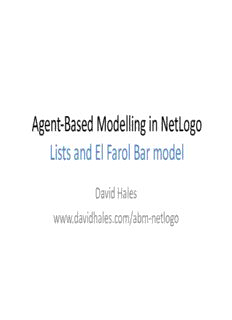
Lists and El Farol model PDF
Preview Lists and El Farol model
Agent-‐Based Modelling in NetLogo Lists and El Farol Bar model David Hales www.davidhales.com/abm-‐netlogo Lists in NetLogo • Lists are a sequence of items • Items can be any type (including lists) • CreaHng lists: let a [ 1 2 3 4 ] ; list of 4 numbers let b [ [ 1 2 ] [ 3 4 ] ] ; list of 2 lists each 2 numbers let c [ “hello” 1 ] ; string, number let d list turtle 0 turtle 1 ; list of two turtles let d list turtles patches ; list of two agentsets Lists in NetLogo • n-‐values generates new lists by calling a reporter iteraHvely: let a n-‐values 5 [?] let b n-‐values 7 [random 10] print a print b • Would produce something like: [0 1 2 3 4] [0 5 3 6 3 9 4] Lists in NetLogo • Adding items to the start and end of a list: let a [1 2 3 4] let b fput 0 a ; b is a with added 0 at front let c lput 0 a ; c is a with added 0 at end print b print c • Would display: [0 1 2 3 4] [1 2 3 4 0] Lists in NetLogo • Removing items from front and end of a list: let a [0 1 2 3 4] let b but-‐first a ; b is a without first item let c but-‐last a ; c is a without last item print b print c • Would display: [1 2 3 4] [0 1 2 3] Lists in NetLogo • Retrieving individual items from a list: let a [ “world” 1 2 “hello” 4 [5 6] ] print first a print last a print item 3 a • Would display: world [5 6] hello Lists in NetLogo • Retrieving subsists from a list: let a [“this” “is” 2 3 “it”] print sublist a 0 2 ; would display: [“this” “is”] print sublist a 2 4 ; would display: [2 3] • Checking if item is member of a list: print member? “this” a ; would display: true print member? 4 a ; would display: false Lists in NetLogo • map applies a reporter to each item in a list or mulHple lists: let a [0 1 2 3 4] print map [? * 2] a print map [? = “hi”] [1 2 “hi” “there”] print (map [?1 * ?2] [1 2 3] [2 1 5]) ; two lists • Would display: [0 2 4 6 8] [false false true false] [2 2 15] Lists in NetLogo • foreach iterates over items in a list, execuHng a command block: let c 0 foreach [1 2 3] [set c c + ?] create-‐turtles c let a (list turtle 0 turtle 1 turtle 2) foreach a [ask ? [forward 1]] • Would create 6 turtles and move the first 3 forward 1 Lists -‐ Task 1 • Write a program in NetLogo that: – creates N turtles and places them randomly – each turtle stores an iniHal empty list – turtles move around in a random walk – If a turtle meets another they have not met before they add their “who” number to end of their list • A turtle meets another if it shares the same patch – When a turtle has met all other turtles it stops moving – When all turtles have stopped the program stops
Description: